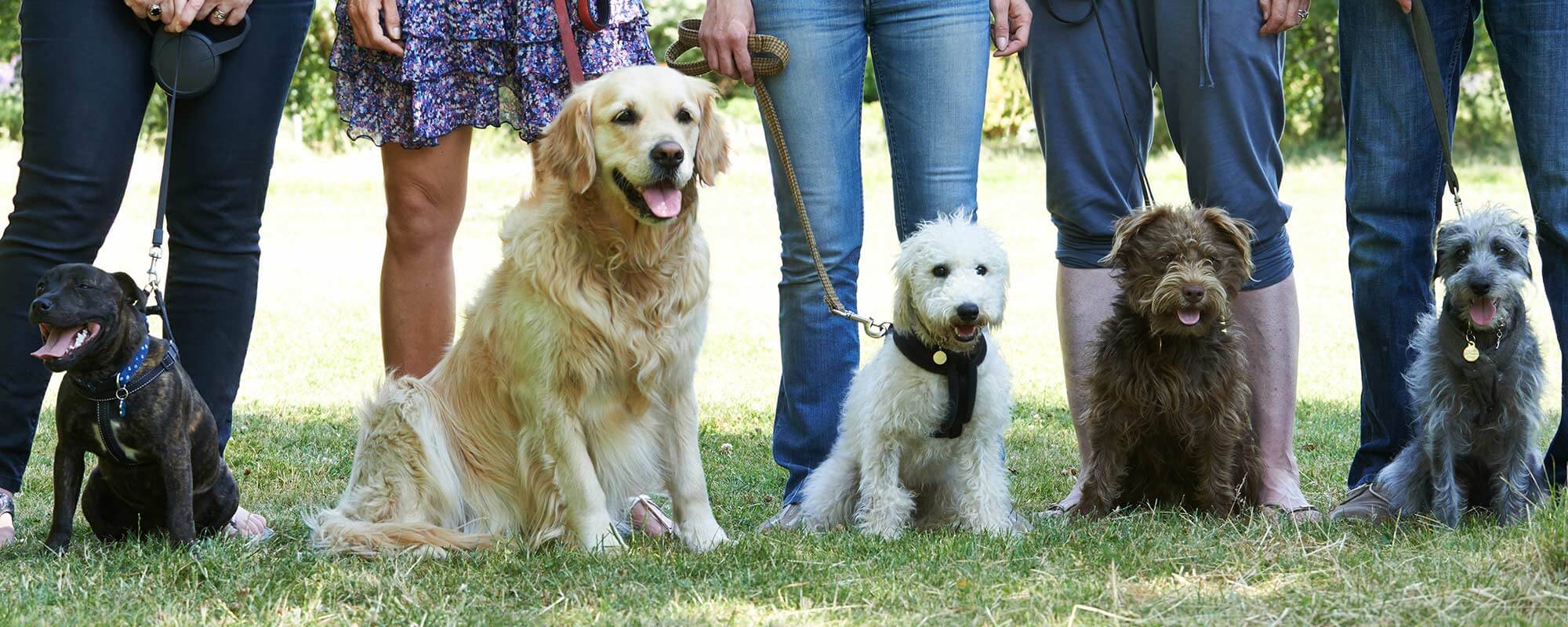Over the Counter Anxiety Supplements for Dogs
Over the Counter Anxiety Supplements for Dogs
By: Dericka Haugan-Customer Service Rep at ZimmVet
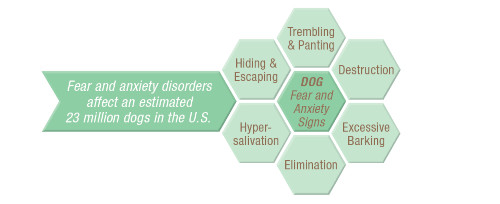
Do you notice your dog is showing signs of anxiety at home, daycare or when out and about with you? While you should always discuss options with your veterinarian there are some over the counter supplements you can try. You may have seen these for sale in your veterinary clinic but what are they and how do they work?
Solliquin
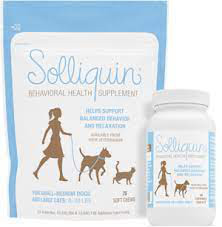
Solliquin is a behavioral health supplement that helps support balanced behavior and relaxation in dogs and cats. You can get Solliquin in a soft chew for dogs and cats between 8-30 pounds or in a capsule for dogs that are 8 pounds or more. Solliquin may take 30-45 days of consistent use to see results.
How does it work?
Solliquin contains a unique blend of amino acids, medicinal plants and protein.
- L-theanine: An amino acid found naturally in green tea. It directly stimulates the production of alpha brain waves, which create a state of deep relaxation, wakefulness, and mental awareness.
- Magnolia / Phellodendron: The combination of Magnolia and Phellodendron extracts appears to be synergistic, with the combination controlling stress and anxiety more effectively than either compound used alone.
- Whey Protein Concentrate: Contains NMXSLQ05®, a trademarked high quality protein source which supplements ten essential amino acids including the precursors of glutathione and serotonin.
This supplement is made to be used in combination with fear avoidance, behavioral modification and anxiolytics (supplements/pharmaceuticals). You can purchase Solliquin at select veterinary clinics or online, if purchased online make sure that you are purchasing through a reputable retailer as an over the counter you would not have to have a prescription to purchase. Purchasing through ZimmVet will give you a palatability guarantee so if your dog does not like them, you can return them to the clinic for a full refund.
Purina Pro Plan Calming Care
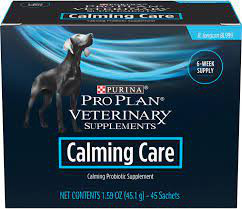
Purina Pro Plan Calming care is a calming probiotic supplement powder to be added to your dog’s food, it is also available for cats. It is recommended to help assist in the management of dogs exhibiting anxious behavior.
How does it work?
Proprietary use of probiotic strain BL999 to help dogs maintain calm behavior
Helps support dogs with anxious behaviors such as excessive vocalization, jumping, pacing and spinning
Helps dogs cope with external stressors like separation, unfamiliar visitors, novel sounds or changes in routine and location
Helps dogs maintain positive cardiac activity during stressful events
Promotes a positive emotional state and healthy immune system in dogs
Excellent palatability
Contains a probiotic with 1×10^9 CFU of Bifidobacterium longum BL999 per packet to support balanced behavior
At select veterinary clinics or online, if purchased online make sure that you are purchasing through a reputable retailer as an over the counter you would not have to have a prescription to purchase. Purchasing through ZimmVet will give you a palatability guarantee so if your dog does not like them, you can return them to the clinic for a full refund.
This supplement is made to be used in combination with fear avoidance, behavioral modification and anxiolytics (supplements/pharmaceuticals). You can purchase Purina Pro Plan Calming Care at select veterinary clinics or online, if purchased online make sure that you are purchasing through a reputable retailer as an over the counter you would not have to have a prescription to purchase. Purchasing through ZimmVet will give you a palatability guarantee so if your dog does not like them, you can return them to the clinic for a full refund.
Adaptil
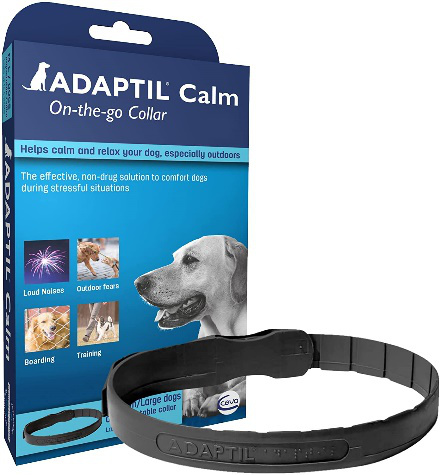
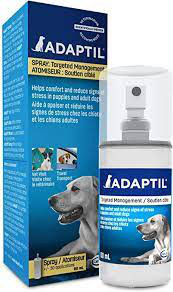
Not ready to use an ingestible supplement? Adaptil is an environmental tool that uses pheromones to help your dog feel calm and relaxed. Adaptil uses the natural pheromones similar to the ones their mothers used to give them natural comforting messages. This is also available for use in cats but be sure to get the correct species product as they do not work on the opposites.
How does it work?
Mother dogs communicate with their puppies through natural messages released into the air: “comforting messages “(called Pheromones). These odorless messages are only perceived by dogs. Cats and people are not affected. These “comforting messages” provide a strong signal of security and comfort to dogs of all ages. ADAPTIL Calm releases “comforting messages” to help dogs feel calm and relaxed at all times.
What not to do?
The collar is meant to be worn and should work for about 30 days, the collar should not be blocked by a harness, coat or regular collar. If it is repeatedly exposed to water, it may not work as long and should not be exposed to chlorine. The spray should not be sprayed directly on your dog and should be allowed to set for 10 minutes prior to letting your dog go into the area where they will be and should not be sprayed inside a carrier.
What is best for my dog?
There are so many options out there and the best way to decide what is best for your anxious pup is to discuss options with your veterinarian. It is best to try a supplement that will be able to be kept on the recommended schedule with each variety. You know your dog and should always advocate for their wellbeing. I hope this helps make discussing options with your veterinarian a little easier for you and helps make these products a little less confusing.
Anxiety in Dogs
By: Monica Bock, Assistant at ZimmVet
As pet owners we want our dogs to feel at ease and to always be happy and healthy! Sometimes depending on the pup and situation however, it can be difficult to manage their stress levels, which may or may not result in numerous behavioral issues. It is important to understand and be aware of issues such as peeing in the house, excessive panting, excessive drooling, chewing at their feet, over licking, etc. may not always be disease related behaviors. Please note however, if your pet is showing any of the listed issues discussed in this post, it is still recommended that the pet be seen by a veterinary professional first before determining if it is truly a stressed induced.
Common signs of stress in pets:
As stated by the AKC the following are common signs of stress and anxiety in pets:
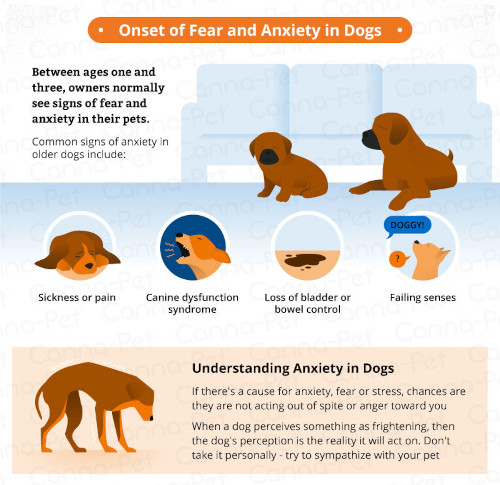
- Aggression
- Urinating or defecating in the house
- Drooling
- Panting
- Destructive behavior
- Depression
- Excessive barking
- Pacing
- Restlessness
- Repetitive or compulsive behaviors
It is important to note that not all pets will deal with stress or anxiety in the same way, as a pet owner getting to know your pet better and dog body language is a key first steps to treating your pet’s overall anxiety.
Different types of stress:
As there is not just one thing that causes anxiety there is typically one of the three types that may cause your pet to exhibit any one of the previously listed signs of anxiety above. One being separation anxiety, fear/noise related anxiety and aging anxiety.
What is separation anxiety?
Separation Anxiety being very common in pets, is the anxiety in which the pet experiences stress when the owner is absent/ way from the pet. While there are different levels of Separation anxiety, it can sometime lead a pet to have some unruly behaviors while their owner is away. According to the RSPCA website, 9 out of 10 dogs experience separation anxiety and may exhibit behaviors such as excessive barking, eliminating in the house, self-harm, or may display more destructive behaviors such as chewing or scratching inappropriate objects.
What is Fear and noise Anxiety?
Your pet may experience fear from loud noises or become anxious at the vet or other new places! Just like human children new experiences and sounds can be scary; depending on how the pet associates the experience anxiety may follow shortly after possibly progressing or becoming worse through time. Some pets may try to escape or hide from the source of their anxiety and in some cases, medication may be needed to manage it.
What is Aging Anxiety?
As our pets age they are going through changes that may cause stress on their mental state. A pet that could like going to the vet may not like it anymore or a pet that loved kids may just want to be left alone and avoid them as they age. It is important to know as a pet ages they may become more painful and not be able to do the same things they once did, because of this they can become stressed and show signs early on.
How to avoid stress:
To keep your pet happy and behaviorally healthy there are ways to avoid anxiety early on in development or to prevent your pets stress and anxiety form worsening over time. If you want to avoid stress/ anxiety early on in puppies or older pups making sure you have basic knowledge of dog body language, specific breed needs and basic personality traits as well as providing proper socialization you too can sometimes avoid major anxiety in your pet
Treatment options:
So, your pet has anxiety, don’t worry all is not lost! After consulting with your Veterinarian, they will provide options based on their observations, that would best suit your pet for them and their type of anxiety. While patients with your pet can play a big part in aiding your pet’s anxiety, there are several things we can try on our journey to an emotionally healthy pet! Your veterinarian may suggest training with a behavioralist-whom is specialized in training pets with anxiety, Socialization, supplemental treatment (natural supplements), or prescribed medication to help your pet’s anxiety.
- Natural/Non-Medication treatment: A natural way to help your pet with anxiety would be training- specifically with a behavioral specialist. A trainer that specializes in anxiety or behaviorally unhealthy pets, will be able to help guide you and the pet
- Natural/Supplemental Treatment: “Natural supplements help dampen the overreaction of the brain” (Krenz 2022), providing the dog with a sense of calm. While one may not see an immediate result, each product has its own trial period in which the medication should be given at specified dosages for best effects. These supplements such as Solliquin, Rescue Remedy, Zylkene and more provide support for mild and moderate anxiety to help a pet strive to become more behaviorally healthy.
- Veterinary treatment-prescription medication: For pets with server anxiety sometimes a vet prescribed medication is needed! Sometimes pets have such anxiety about an event, place, noise, etc. That they need something a bit stronger or maybe even something to pair with one of the other above options. A doctor will evaluate the pet and determine if and what type of prescribed medication best suits your pet. If the pet displays such anxiety that it becomes dangerous, uncomfortable or harmful for you the owner, the pet themselves or others around the pet this may be the best option for you.
Pet Obesity
By Dr. Maria Krenz, DVM – ZimmVet
Multiple factors lead to pet weight gain. Heavy pets have more problems with arthritis, and they are at higher risk for diabetes, heart disease and many other ailments. Preventing weight gain and obesity in your pet can add years to their lifespan, creating more time to spend with your special friend.
Measure your Pet’s Food
Pet owners need to take control of their pet’s calorie intake. Most pets, if left to eat as they wish, will overeat and become obese, even as early as 6 months of age. The pet food bag gives a guideline of how much to feed your pet. The key is to measure the food for the weight your pet should be, or its ideal weight. Your veterinarian can help you determine the ideal body weight and calculate the appropriate calories for your pet.
Separate Feeding
Feeding can be difficult in multi-pet households. Each pet should be separated during feeding to make sure they are eating the correct amount and type of food for their size. Pets should be fed the correct food based on their life stage: Puppy/Kitten, Adult or Senior. Dogs over 50 lbs should be fed a large breed dog food. Pet food needs to include a grain. There are many tools available to help with multi-pet feeding. Having separate kennels for each pet to eat in can work. A newer product on the market Sure Pet Feeder (surepetcare.com) is linked to a microchip or tag and only opens for the pet linked to the feeder.
Treats
Many pet owners are feeding the correct amount of pet food, but their pet is getting too many calories from other sources. It is common, especially with small dogs, for owners to be giving 2-times or more of their daily calorie needs in treats. People food, dog treats, rawhide bones, dental bones or anything a pet ingests, counts toward their daily calorie allowance. Your veterinarian can help you calculate how many calories per day in treats your pet can have, which is normally no more than 10% of their daily calories. For small dogs this can be as little as 10-20 Calories per day, larger dogs may be able to get 100-200 Calories per day in treats.
Inactivity
Keeping your pet active is an important part of managing your pet’s weight. Older pets that are having joint pain can struggle with activity. Getting an older pet on appropriate pain management can help to get them more mobile again. Winters can also face a challenge to stay active. If your pet doesn’t like spending time outdoor in the cold consider a daycare facility that has indoor play space like ZimmVet.
Other Tools
Your veterinarian can help you formulate a weight management or loss plan for your individual pet. Other treatments may include blood testing for diseases such as hypothyroidism and prescription weight loss diets. Adjusting the food intake of your pet can be a challenge if you have multiple pets. However, your veterinarian can help you work through problems to create a solution for a healthy weight for your pet.
Disclaimer: This written content is meant to be educational and is not medical advice. Always consult a veterinarian about medical advice for your pet.
House plants and Pets
By: Mysi Szczech, ZimmVet Assistant
There are many options that are safe for your pets as well so you can all live happily! Safe plants not only provide an aesthetic appeal to your home but they also have benefits such as regulating humidity levels in the home and minimize dust content.
Common houseplants that are TOXIC to pets are lilies, aloe vera, ivy, jade, dumb cane (dieffenbachia), elephant ear, pothos (devils ivy), ZZ plant, asparagus fern, cyclamen, azaleas, tulips, kalachoe, hyacinth, sago palm, etc.
Common houseplants that are SAFE to be around pets are baby tears, spider plant (cats love this plant!), calathea, fern, Christmas cactus (or any cactus, little pokey but safe), haworthia, friendship plant, parlor palm, burro’s tail, etc.
If you suspect that you pet has been in contact with a toxic plant they may have oral irritation, excessive drooling, vomiting, difficulty breathing. You should also contact your local veterinarian or call the ASPC animal poison control at (888) 426-4435.
Always remember to look up information on a plant if you plan on adding it to your home to know how to care for it and where to keep it to keep our fur babies safe!
Heat exhaustion in dogs
By Gianna Tuckner CVT at ZimmVet
Heat exhaustion can happen because most dogs want to be with the people they love. Knowing the signs of heat stress and reacting to a pet in danger is important.
Humans deal with hot weather by sweating, but dogs shed heat by panting. In the wild, dogs seek shade during the hottest part of the day; left to their own devices, most pet dogs will, too — unless they are lured into activity by playing fetch or going on a walk.
Leave your pet at home when it’s warm, never leave your dog in the car even on a mild day (heat builds up quickly), and exercise your pet in the cooler mornings or evenings. If you wonder if a street or sidewalk is too hot for your pet to walk on, place the palm of your hand on the pavement: if it’s too hot for your hand, it’s too hot for your dog’s feet.
For dogs with short faces, such as Bulldogs, Pugs, Pekinese, and mixes of these breeds, the risk is even higher. These dogs cannot breathe well even under the best of circumstances and should be kept in air-conditioned areas during the warmer months. Older dogs, overweight or obese dogs, and unfit dogs are also at higher risk.
A dog’s normal temperature is between 100.0-102.5. More than a couple of degrees up can be concerning, and it’s certainly an indication that you need to get your dog calm and cool. Since most people don’t carry a thermometer around, they have to rely on the signs of an overheated dog. These include: Heavy or rapid panting, drooling, distant-eyed expression, anxiety and restlessness, confusion, exhaustion or fatigue, bright red or blue/purple gums, vomiting or diarrhea and collapse.
If your dog is overheated, move your pet immediately to the shade or an air-cooled area. You can use cool water, not ice-cold water or ice, on your dog’s belly, fousing on the groin or put a fan in front of your dog and have it blow over them. If you have a thermometer, lubricate the tip and insert it gently into the rectum to get an accurate temperature to share with your veterinarian. Offer your pet cool water to drink but don’t force water into your dog’s mouth.
Then call your veterinarian or an emergency veterinary clinic to let someone know you are on your way.
Adapted from Dr. Marty Becker, DVM Vetstreet article
Dog Parks
By Abby Gustafson, ZimmVet Receptionist
Did you just get a new dog? Well, congratulations! You probably want to take him/her to the nearby dog park now, right? Have you thought about this? Taking your new dog to a dog park, regardless if on or off leash, can be a bit rewarding as well as scary to pets and to you.
Let’s dig a little deeper into this. What are the benefits of a dog park? Well, for starters, your canine companion gets socialized with other dogs and humans. A tired dog is a happy dog. Your dog can learn from other dogs on how to play, interact, and possibly have fun.
On the other side, a dog park can carry diseases and parasites if dogs go that haven’t been dewormed or vaccinated. Other owners might not fully pay attention to their dog as it runs wild without notice.
Other dogs might not be friendly to other dogs – some dogs may not like others that are bigger or smaller than them.
It would be best for your dog to be trained to the recall or come command before heading to a dog park. Making sure your dog will come to you whenever you call it over, as well as making sure your dog is up to date on vaccines as well as a dewormer.
How to Teach a Cat to Fetch
By: Amy Johnson, CVT ZimmVet
Yes, you read that title correctly — cats can do the same things that dogs can do, and maybe even better. Discover how to teach a cat to fetch, and impress all of your neighbors and friends.
Think Like a Cat
Dogs love to please owners; however, cats are more concerned with pleasing themselves. By realizing this simple concept, you can understand why teaching a cat to fetch has to be approached differently from how you would train your dog. When it comes to training a cat, there are some basic techniques that you must know in order to be successful. These basic principles all start with the letter “R,” so that makes it a little easier to remember!

Respect
You need to respect what cats do and don’t like. Don’t stare at your cat or make loud noises during training or playtime. When they doesn’t feel up for play, don’t force it. Try to train them when they are feeling extra playful.
Reinforcement
Consistently recognize when your cat does things you want her to do, and be consistent in how you let your cat know she is doing things you don’t like (for instance, walking on your counters). A firm “no” or clap when she misbehaves may work, but when she does something you approve of, don’t give her a round of applause. Instead, pet her or give her a treat.
Rewards
Cats love small treats as a reward for good behavior. One of the secrets of how to teach a cat to fetch may be hidden in simply having the right treats. Use them only when she does the action you want her to, and don’t overdo it, so as to not add unwanted pounds.
Timing Is Everything
First, you have to get to know your cat, and build a trusting and loving relationship before you can start training them to do tricks or play fetch. Figure out what toys or items in your house they’re drawn to the most. These items are the ones you should try to use for playing fetch.
Cats are drawn to hunt and pounce on things — throwing a soft item and allowing your cat to chase it, and then going over and placing a treat near the item may reinforce and reward the first step in fetching. After a few days of successfully getting your cat to pounce or go near the item you throw, you are ready to attempt having them bring you the item. You can do this by leaving a trail of treats after throwing the item. As time goes on, make the treats closer to you and farther from the object. Keep in mind, it is best to do all of this at a time of day when your cat is most active. Make sure to always use the same verbal queues to reinforce the action such as “fetch,” or “bring it here.”
Fetching Failures
If it seems like all of your attempts at training your cat to fetch have failed, take a break for a few days and then try again with new toys and different treats. Not all dogs like the same games, so it is possible your cat won’t ever be interested in fetch. However, don’t give up too quickly. Allow several different people in your home to try to train her. Cats sometimes bond with one person more than another and may only want to play fetch with their favorite human.
If you are successful, be sure to catch it on video so that all of your friends believe you! Everyone loves fun cat videos.
How To Prepare For My Pet’s Surgery
By: Ashley Middendorf, CVT ZimmVet
- Presurgical exam: Each pet will come in for a presurgical exam prior to the day of surgery. This will allow the doctor to evaluate your pet as well as update any necessary lab work and vaccines that your pet needs.
- Schedule the surgery: The actual surgical appointment can be schedule over the phone or in person. Wait times vary depending on the procedure but the sooner you schedule the better.
- Consent form: The surgery consent form will be sent to you via email and be completed prior to the surgery day.
- Night before surgery day: No food after 10pm, but water is ok up until your pet is at the clinic
- Morning of surgery: You’ll be dropping off your pet with the surgery technician at a scheduled time usually between 7:30 am and 8:30 am.
- Surgery will be completed for your pet.
- After Surgery: You will be notified of you pets completion of surgery and how he or she is recovering.
- Discharge time: You will be scheduled a discharge time to pick up your pet and go over discharge instructions/medications with a certified veterinary technician.
- Recheck: Depending on what surgery your pet had you may need to bring he or she back for a recheck with the surgery doctor in a certain time frame.
Leptospirosis
By Keri Hesse, CVT ZimmVet
What is Leptospirosis?
Leptospirosis is a bacteria that is found in stagnant, slow moving water but can be found in the soil near or around where there had been stagnant water. The common carriers of Leptospirosis is wildlife which is the most common route of exposure to our pets. This disease is also zoonotic; meaning that our pets can transmit it to us.
How does our beloved pets become infected?
The bacteria is penetrated through the skin through a cut/abrasion from the contaminated water or the contaminated urine of wildlife, reproductive organs exposed to the bacteria, even the consumption of infected tissues can be the cause of Leptospirosis.
What happens if my pet gets Leptospirosis?
Once exposed to Leptospirosis, the bacteria is spread through the bloodstreams causing inflammation of the vessels, fever, abnormal bleeding, and bruising of tissues. By the time symptoms have started showing, Leptospirosis has set up in the kidneys, causing inflammation of the kidneys and can disrupt urine production, ultimately leading to kidney failure. Some strains of Leptospirosis can cause inflammation of the liver and ultimately causing liver damage or failure.
Is there treatment for leptospirosis?
If caught readily, Leptospirosis can be treated with hospitalization, IV and oral antibiotics, and IV fluids to help flush the bloodstream and kidneys of Leptospirosis. During this time, it is crucial to protect ourselves from the contaminated urine to prevent infecting ourselves.
Can I prevent my pets from getting Leptospirosis?
Leptospirosis can be prevented ultimately with a vaccine.The first vaccine is given and then boosters in 3-4 weeks and lasting a year. So, it is important to make sure your pet is vaccinated yearly for this bacteria.
Most common thought is that our dogs that are either hunting, camping or around our lakes are the most exposed pets. But, with the amount of wildlife that come into our backyards any dog could be exposed to these serious bacteria. This can all be prevented with a yearly vaccine, please vaccinate your dogs. If you have questions, reach out to one of our staff members for more information.
Welcome to ZimmVet’s Pet Care Blog!
Welcome to our pet care blog! Please take a look at the rest of our site while we work on our first post!


